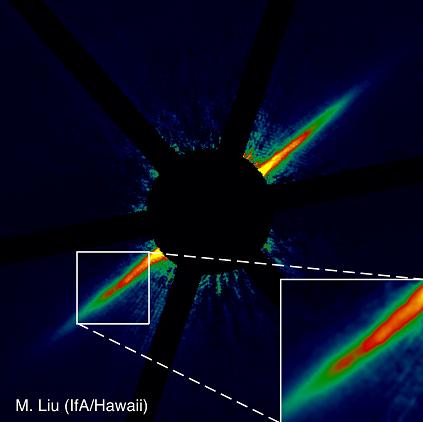The sharpest ever image of a disk of dust around a star was taken, revealing structures that represent the presence of planets in the area
Amit Oren

Dr. Michael Liu, an astronomer at the Institute of Astronomy at the University of Hawaii, obtained a high-resolution image of the star AU Microscopii (AU Mic) using the Keck telescope, the world's largest infrared telescope.
The star is only 33 light-years away, and is considered the closest star to have detectable dust disks, the same disks that are thought to be the site of the formation of planets [protoplanetary disks].
"We can't image the planets around AU Mic yet, but right now, even now, they are not completely hidden from us, revealing themselves in their gravitational effects, creating patterns in the dust lanes around the star," said Doctor Liu.
The results were published on August 12 on the "Science Express" website and in September in the "Science" magazine.
A disk of dust will often appear uniform and symmetrical, because any disturbances in the material in it will be corrected by the gravity of the star and the rotational movement of the material. However, in the case of AU Mic there is a difference; Dr. Liu discovered that the disc is not symmetrical and is full of lumps of material as opposed to empty spaces. These structures were probably created due to the effects of accompanying planetary objects - other planets.
The clumps of material in the disk are separated by about 25 to 40 astronomical units from the central star (astronomical unit - the average distance between the Sun and the Earth, about 150 million km.) In our solar system, this distance is roughly equal to the distances to Neptune and Pluto.
AU Mic is a dim red star, with a mass of about half that of our sun and an energy emission of only about a tenth of that. Previous studies have shown that its age is about 12 million years, a period in which it is believed that a planetary system could form in In comparison, our age is about 4.6 billion years, 400 times older, and the process of the formation of the planets ended a long time ago.
"Researching young stars like AU Mic, we learn about the process of the formation of planets and solar systems in their formation. As a result - we learn about the formation of our solar system and its planets," Liu said.
From studying the images alone, it is not possible to say yet what kind of stars are there, only that the stars are massive enough to spin and create disturbances in the dust bands. Despite this, many structures in the dust disks appear elliptical, and from this we can learn that the orbits of the planets are also elliptical. This is different from our solar system, where most of the planets follow a circular orbit.
Images of disks near stars are very rare. The light captured was actually reflected from the star by small dust particles in the disk. The new images are thirty times sharper than their predecessors, and made it possible to detect lumps in the discs.
The telescope used by Dr. Liu, the "Kek 2" telescope, is located on Mauna Kaa in Hawaii, and consists of two huge infrared telescopes, each equipped with a mirror that is about ten meters in diameter. The telescopes are equipped with coordinated optics and technology that corrects the atmospheric disturbances obtained in the image.
The photos are the sharpest taken; A resolution of about 1/25 of a second of arc - about 1/500,000 of a full moon. For example: if a person had the possibility to see with such quality and sharpness, he could read a magazine from a distance of about one and a half kilometers!
In the case of AU Mic, due to the distance, the smallest visible features are about 0.4 AU (about 60 million km), less than half the average distance from the Earth to the Sun
"We are entering a new era in high-resolution astronomical photography. Dr. Liu's spectacular photos of doubtless planets and their formation around the star AU Mic are groundbreaking in this field, and for many years they did not believe that one day such spectacular photos would be taken - from a space or terrestrial telescope. This is indeed a very exciting time for all of us!" Says Dr. Frederic H. Shafe, director of Mitzpe Kek.
Initial edition and print versions: http://arxiv.org/abs/astro-ph/0408164
This work was supported in part by the National Science Foundation.
Source: Institute of Astronomy at the University of Hawaii
